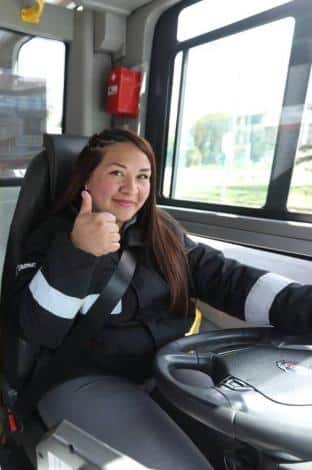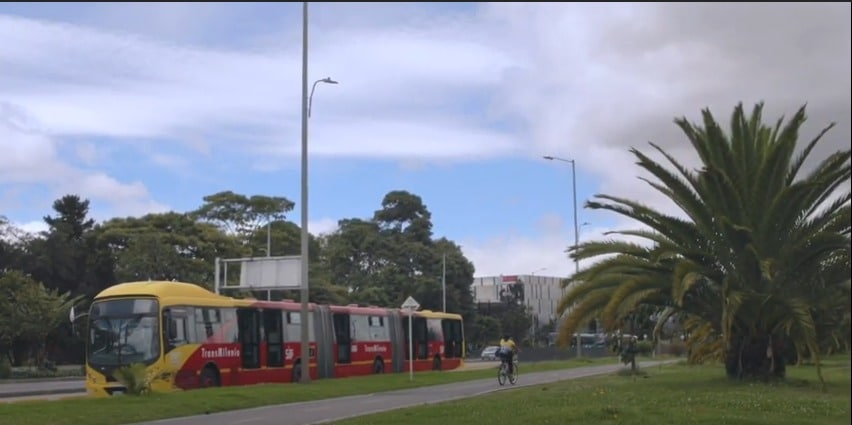
Daisy Leonor Jaime’s driver’s license certifies her as a brave woman. She has been driving buses since she was 16 years old, and today, at 48, she has completed 9 years as a driver in Bogotá’s public transportation system.
My job is as bus operator. I started working as a bus driver. Since then, I have moved up to Buseton, Padron, and now, to Alimentador.
Daisy Leonor Jaime, Bus Operator
Buseton, Padron and Alimentador are three different bus types operating in Bogota’s public transportation system. Daisy is one of the 12 drivers working on the recently launched M-route run by the firm SUMA in Bogota’s Tunjuelito district, which is operated exclusively by women.
With her work as a driver, she raised her two children and gave them what she lacked: education up to the university. “I learned to drive in Bogotá’s hills. Nowadays, it is more normal to see a woman driving a bus. When I was 16, everyone looked at me in amazement, especially because I learned on those old buses. It was complicated, but I liked it.”, Daisy says.

With her work as a driver, she raised her two children and gave them what she lacked: education up to the university. “I learned to drive in Bogotá’s hills. Nowadays, it is more normal to see a woman driving a bus. When I was 16, everyone looked at me in amazement, especially because I learned on those old buses. It was complicated, but I liked it.”, Daisy says.
Today, women can be found at the wheel of Bogota’s Public Transportation System’s Buses and TransMilenio‘s articulated and bi-articulated buses. However, the reality is that there are only a few of them. According to TransMilenio figures, out of the 23,965 drivers in the system, only 328 are women: 1.4%.
Like Dasy, Betany Moreno is also part of this small group. Betany, a 26 years old single mother, also took on the challenge of being in charge of a bus. “At 17, I started driving a small truck. My actual job was as a warehouse assistant, but I also helped with deliveries. I’ve worked on many things; I even sold sausages on the street. I have had many jobs. But SUMA allowed me to enter with the driver’s license I had. I hope to be here for a long time”, Betany says.
Daisy: “Before working with operators, I worked in traditional (non formalised) transportation: I started when I was 16. So, I have a lot of experience. I joined the SUMA nine years ago. I passed the tests and requirements made by the company, so here I am. I am no longer afraid of driving or anything like that because, thanks to God, I have a lot of experience. My family is very supportive and tells me: ‘You are a warrior. Go ahead’. The users? They have received us very well. When girls and boys look at us they say: ‘Oh! A woman, we are safer, we are confident,’ and congratulate us.”

Betany: “I entered the system because my father worked as a driver: he was an operator in another company. I was very impressed to see his schedule and flexibility. That is why I was motivated to apply for that company. I joined the company about a year ago and started in minibuses, a smaller type of bus. I moved on and I am currently on the standard bus. At the moment, my schedule is in the morning. I start at 3:00 – 3:30 a.m., depending on the schedule, we get 8 hours, or sometimes we get periods of 5 or 6 hours. I have a little girl, and it has been hard for us because we live alone, but I have time to spend with her, take her to school, and pick her up. It has been great to share time with her. My family has always been there for me. They tell me that I am fearless and a warrior. I have never had any problem with the users (as them being rude to me or something like that). On the contrary, they always tell me how cool it is to see such a young woman doing this.
For a woman to have the right to work as a driver in a public transport system is not a “whim”, it is a life-changing opportunity. According to the study Inclusion of women in driving tasks in Santiago’s public transport system, carried out by the Transport Gender Lab of Santiago (Chile), the incorporation of women in bus companies of Trasantiago (Red Metropolitana de Movilidad) has had a substantial impact on their economic autonomy.
The sudy shows that the vast majority of female drivers indicated in the interviews and focus groups that their economic situation has improved considerably. They are able to pay debts, save and access goods previously unaffordable, such as buying a car or a house, going on vacation, sending their children to a better school or giving them what they need in material terms. The study also highlights that driving can be a formal employment option for this population with poor employment and salary conditions: in Bogota, while unemployment among men is 14.1%, for women is 17.%.
The interviewed female drivers consider that they have been brave and have broken barriers and prejudices (…) which generates a high sense of pride for them.
Transport Gender Lab
But why is it so difficult to see women behind the wheel? And, why do women like Daisy and Betany make up a mere 1.4%? Marina Moscoso, technical director at DESPACIO, gender and mobility expert, and co-author of the study Women in Bogotá’s Transport: the result, identifies four types of barriers: individual, environmental, access and permanence, and organisational.

Hiring more women is not the only solution; we must change the predominantly male culture.
Women in Transportation in Bogotá
“From our upbringing, we have gender stereotypes that affect how we project ourselves and what we want to do. There are values associated with what we know as the sexual division of labour, where we believe there are men’s and women’s jobs. These notions are reinforced at school and in the family. For example, if the father goes to fix the car on Saturday, he takes the boy, not the girl. These are individual and social barriers”. Moscoso also adds that these barriers, in turn, feed the access barriers: that is, they do not allow a woman to have the training to access this type of work.
“For example, to drive a TransMilenio biarticulated bus, you need a specific type of licence for larger vehicles, and most women do not have it,” says Moscoso, noting that even when women who meet the requirements encounter organisational barriers: there are no inclusive or permanent vacancies, the work environments are not safe, there are dynamics of harassment, or the schedules do not adjust to the care roles that fall on women.
However, according to TransMilenio, there are strategies to assess the barriers. The company said that employment fairs are organised to support local concessionaires in recruiting staff. Also a Seeding Plan is “one of the mechanisms to facilitate women’s access to the system’s job offers”.
Operators are required to have a primary school degree, a C1, C2 and C3 type license and at least one year of certified experience in cargo vehicles of at least 1.5 tons or passenger transport vehicles. The Seeding Plan provides driving training and makes the requirements more flexible. They require only a C1 type license, one year of certified experience as a vehicle driver and a primary school certificate.
In addition to these strategies, Chile has implemented state-funded scholarships and an annual award for the best female driver, increasing the number of women drivers in public transport from 100 in 2013 to more than 1,000 by 2022. This share is expected to grow thanks to new policies requiring a quota of female participation in transport companies’ operations.
Paola Tapia, former Chile’s Minister of Transport and current director of Santiago’s Metropolitan Transport Board, says that this benefits everyone: “To begin, women’s performance is better than men’s because they help reduce traffic accidents, generate more harmonious working environments and procure friendlier attention, which passengers appreciate. In addition, they develop self-esteem, as shown in a study produced by the Inter-American Development Bank in 2018, underlining that in the Chilean system, women value the job stability, career, income, and the independence that this activity brings”.
Yet, for Moscoso, it is crucial to remark: “Although there may be arguments to say women are better drivers, the main point (to recruit them as such) is that women also have the right to work in these sectors and access better economic opportunities. Otherwise, we are at risk of creating stereotypes”.
Little is known that the arrival of 1485 new electric buses to Bogotá -1061 of which are already running- together with the national policies to promote public transport electrification, will, over a five-year horizon, generate a nationwide demand for 934 technicians and 10,653 trained drivers for electric vehicles. If the conditions are created, many of these jobs could be for women. This is the conclusion of the study: Diagnosis of capacities for designing a human talent training program for promoting mass transportation systems based on electric buses, financed by the German Cooperation Agency in Colombia (GIZ) and carried out by DESPACIO and KAPTA.
According to María Fernanda Ramírez, Sustainable Mobility Leader at DESPACIO, the study evaluates which vacancies will be generated throughout the electric public transport value chain, from e-bus procurement to daily operation. “There are three points where we need more people and training: drivers, maintenance technicians and those who would tune and prepare the vehicle”.
During this study, a partnership with the National Learning Service-SENA was made to complement the programs and guarantee women’s access through levelling programs while addressing gender inequality. “There are three levels of electricity operation courses. Many times, women do not have the knowledge to start at the first level because these are contents that have been traditionally male-oriented. So we must devise a ‘level zero’, which is useful for both women and men,” explains Ramírez.
One of the industries with the greatest labour inequality for women is the automotive industry. Cultural reasons and stereotypes are part of the glass ceiling that must be broken.
DESPACIO, KAPTA
Alejandro Ceballos, Technical Advisor for GIZ’s TRANSfer III project, points out that the document is already in the hands of the National Government for them to adjust and implement the program. “It is the perfect opportunity. This technological transition will require more labour; therefore, the new labour force should be women,” said Ceballos.
Moscoso comments the current moments are advantageous since, due to the novelty of the technology, the field is even for both men and women. “Not so much previous knowledge presents itself as a difference between genders. Men don’t have as much prior knowledge, putting them ahead of women. The field is even; it is the opportunity for men and women to enter this new sector or market”.
ANA PUENTES – journalist for the newspaper El Tiempo
*With support from Loren Valbuena
On Twitter: @soypuentes
Translated by TRANSfer III Colombia, from the original article in Spanish: https://www.eltiempo.com/bogota/transmilenio-por-que-es-importante-que-haya-mujeres-conductoras-de-buses-679373